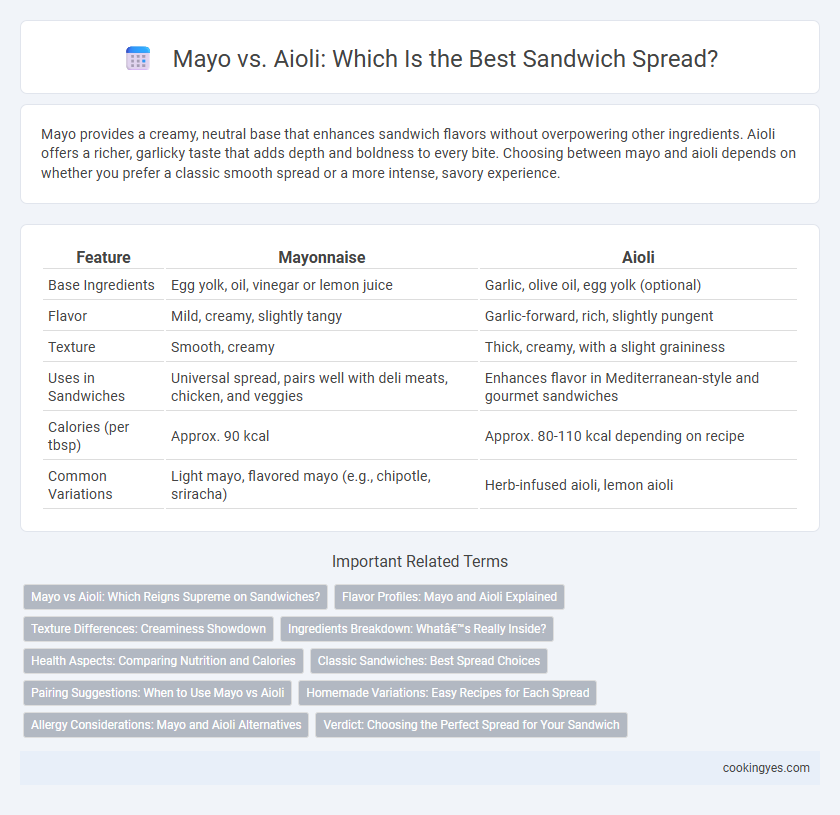Mayo provides a creamy, neutral base that enhances sandwich flavors without overpowering other ingredients. Aioli offers a richer, garlicky taste that adds depth and boldness to every bite. Choosing between mayo and aioli depends on whether you prefer a classic smooth spread or a more intense, savory experience.
Table of Comparison
| Feature | Mayonnaise | Aioli |
|---|---|---|
| Base Ingredients | Egg yolk, oil, vinegar or lemon juice | Garlic, olive oil, egg yolk (optional) |
| Flavor | Mild, creamy, slightly tangy | Garlic-forward, rich, slightly pungent |
| Texture | Smooth, creamy | Thick, creamy, with a slight graininess |
| Uses in Sandwiches | Universal spread, pairs well with deli meats, chicken, and veggies | Enhances flavor in Mediterranean-style and gourmet sandwiches |
| Calories (per tbsp) | Approx. 90 kcal | Approx. 80-110 kcal depending on recipe |
| Common Variations | Light mayo, flavored mayo (e.g., chipotle, sriracha) | Herb-infused aioli, lemon aioli |
Mayo vs Aioli: Which Reigns Supreme on Sandwiches?
Mayonnaise, a classic sandwich spread made from oil, egg yolk, and vinegar or lemon juice, offers a creamy, mild flavor that complements a wide variety of sandwich ingredients. Aioli, traditionally an emulsified garlic and olive oil sauce, provides a bolder, more pungent taste profile that enhances sandwiches with Mediterranean or robust flavors. Choosing between mayo and aioli depends on the desired flavor intensity and the specific sandwich composition, with mayo favored for versatility and aioli preferred for adding a distinctive, savory punch.
Flavor Profiles: Mayo and Aioli Explained
Mayonnaise offers a creamy, tangy base with a subtle sweetness that enhances sandwich fillings without overpowering them. Aioli, traditionally made with garlic and olive oil, provides a robust, savory flavor that delivers a punch of boldness and depth. Choosing between mayo and aioli depends on whether you prefer a milder, smooth spread or a more intense, aromatic taste to elevate your sandwich experience.
Texture Differences: Creaminess Showdown
Mayonnaise offers a smooth, creamy texture that spreads easily and blends well with sandwich ingredients, providing consistent moisture without overpowering other flavors. Aioli, traditionally made with garlic and olive oil, boasts a thicker, slightly grainier texture that delivers a richer mouthfeel and more pronounced flavor intensity. The choice between mayo and aioli influences the sandwich's overall creaminess, where mayo enhances uniform softness while aioli adds a textured depth and boldness to each bite.
Ingredients Breakdown: What’s Really Inside?
Mayonnaise typically contains a blend of oil, egg yolks, vinegar or lemon juice, and seasonings, creating a creamy and mild spread. Aioli is traditionally made from garlic, olive oil, egg yolks, and lemon juice, offering a richer, more robust garlic flavor. The key ingredient difference lies in the type of oil and the presence of garlic in aioli, impacting both taste and texture in sandwich applications.
Health Aspects: Comparing Nutrition and Calories
Mayonnaise and aioli differ significantly in nutritional content and calorie count when used as sandwich spreads. Traditional mayonnaise typically contains higher levels of calories and fats due to its base of egg yolks, oil, and vinegar or lemon juice, delivering approximately 90 calories per tablespoon, whereas aioli, made with olive oil and garlic, offers heart-healthy monounsaturated fats and slightly fewer calories. Choosing aioli over mayonnaise can enhance a sandwich's health profile by reducing saturated fat intake and increasing antioxidant-rich ingredients like garlic and olive oil.
Classic Sandwiches: Best Spread Choices
Classic sandwiches often benefit from the creamy texture and mild tang of mayo, which enhances flavors without overpowering the ingredients. Aioli, made from garlic and olive oil, offers a bolder, more aromatic taste ideal for Mediterranean-inspired sandwiches. Choosing between mayo and aioli depends on whether a subtle or robust spread is desired to complement sandwich fillings like turkey, ham, or roasted vegetables.
Pairing Suggestions: When to Use Mayo vs Aioli
Mayo complements classic deli sandwiches, chicken salad, and BLTs by providing a mild, creamy base that enhances other flavors without overpowering. Aioli pairs well with gourmet sandwiches featuring roasted vegetables, grilled meats, or bold cheeses, as its garlicky richness adds depth and a Mediterranean flair. Use mayo for light, everyday sandwiches and opt for aioli when aiming for a more robust, savory spread that elevates artisanal ingredients.
Homemade Variations: Easy Recipes for Each Spread
Homemade mayonnaise combines egg yolks, oil, vinegar or lemon juice, and mustard for a creamy, tangy sandwich spread that can be customized with herbs or garlic for extra flavor. Aioli, traditionally an emulsion of garlic, egg yolk, and olive oil, offers a richer, more intense garlic taste, perfect for those seeking a bold sandwich experience. Both spreads are simple to prepare from scratch, allowing control over ingredients and flavors to enhance any sandwich.
Allergy Considerations: Mayo and Aioli Alternatives
Mayo typically contains eggs, a common allergen, making it unsuitable for individuals with egg allergies, whereas traditional aioli also usually contains garlic and egg yolks, potentially triggering sensitivities. Egg-free mayo alternatives, often made from plant-based ingredients such as soy or aquafaba, provide a safe option for egg allergies, while some aioli versions replace eggs with vegan mayonnaise or avocado to accommodate dietary restrictions. For those avoiding allergens, it's essential to check ingredient labels or prepare homemade spreads using allergy-friendly substitutes to ensure safe and flavorful sandwich toppings.
Verdict: Choosing the Perfect Spread for Your Sandwich
Mayonnaise offers a classic, creamy texture with a mild tang that complements a wide range of sandwich fillings, making it a versatile choice for everyday use. Aioli, featuring garlic and olive oil, delivers a bolder, more robust flavor profile suited to gourmet or Mediterranean-inspired sandwiches. The perfect spread depends on personal taste preferences and the sandwich ingredients, with mayo favored for subtlety and aioli for added depth and complexity.
Mayo vs aioli for sandwich spread Infographic

 cookingyes.com
cookingyes.com